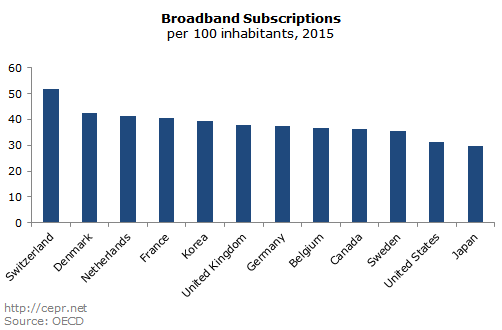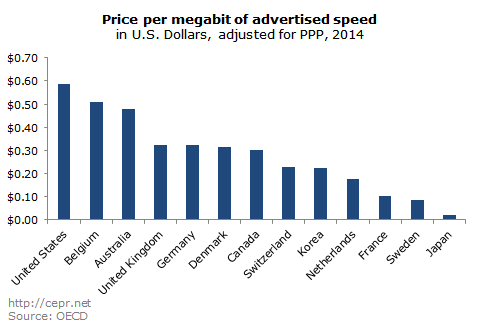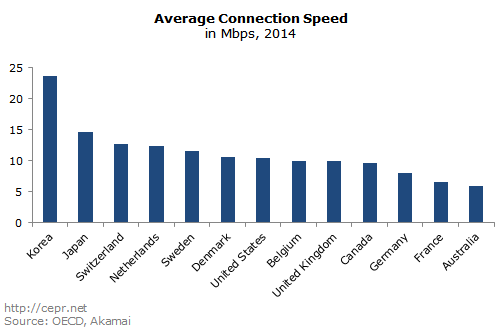December 23, 2016
While the U.S. is the birthplace of the Internet, it currently falls behind other countries in making high quality broadband connections widely available.
The OECD’s overview on broadband connectivity shows the U.S. provides costlier and lower quality broadband than other countries. Furthermore, the U.S. trails most other countries in percentage of people with broadband subscriptions.

The figure above illustrates the number of broadband subscriptions per 100 inhabitants in a series of high-income OECD countries. Switzerland tops the list, with almost 52 subscriptions per 100 residents. On the other end of the spectrum, only 31 percent of inhabitants have a broadband subscription in the U.S. The only country with a lower broadband subscription rate is Japan, at 30 percent.
However, a breakdown by type of broadband reveals that in Japan three-quarters of broadband subscriptions are for fiber optic connections, the fastest type of broadband available. Thus Japan is almost at the top of the list in terms of fiber optic subscriptions — 22 per 100 inhabitants. South Korea has the most fiber optic subscriptions — 28 per 100 residents. In the U.S., only 3 percent of people are subscribed for fiber optic broadband.

Internet in the U.S. is not cheap either. In the above figure we can see that even adjusted for Purchasing Power Parity (PPP), the US has the highest prices per megabit of advertised speed. In the U.S., one megabit of speed costs 60 cents, while in the U.K., Germany, and Canada it is around 30 cents. In Japan, one megabit of advertised speed only costs 2 cents.
Using data collected from speed tests conducted by Akamai Technologies, the OECD also offers insight into the average connection speed in these countries.

The figure above illustrates the average connection speed as measured by tests conducted by Akamai Technologies. The tests found that South Korea has the fastest internet, at an average of 24 megabits per second (Mbps), followed by Japan with an average of 15 Mbps. Internet speed in the US ranks somewhere in the middle, with the average connection at 10 Mbps.
The lower number of broadband subscriptions is not surprising given that people in the U.S. pay more than those in most other countries for worse service. The fact that 3 percent of people do not have access to any internet providers, 9 percent can choose from only one provider, and 32 percent between two providers probably isn’t creating many incentives for internet providers in the U.S. to offer better services at lower prices.






